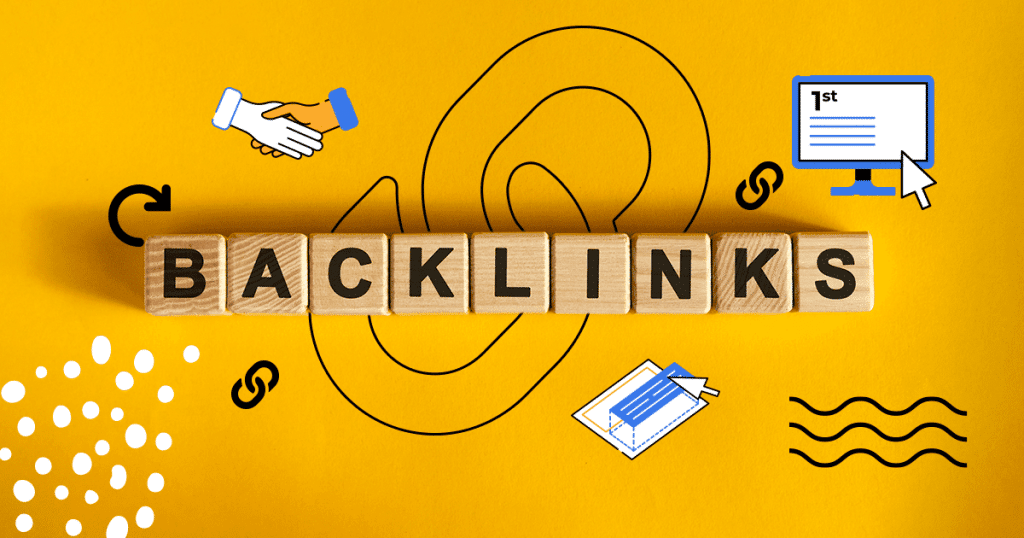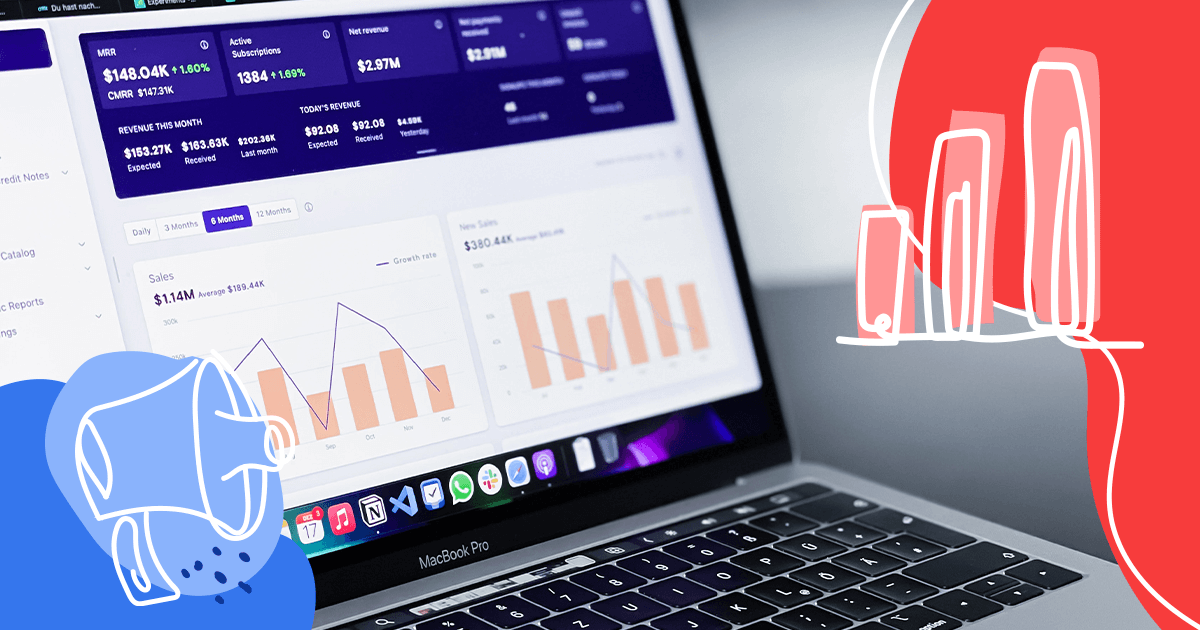One of the most important strategies for successful SEO is link building.
Among the more than 170 ranking factors Google uses, there are two that have the greatest impact:
- the quality of the content — ability to respond to the user’s intention;
- the number of backlinks received.
For this reason, I will explain what backlinks are and why they have such an important impact on your SEO strategy.
You may have excellent content on your site and a great loading speed, but still aren’t appearing at the top of search engine results.
A lack of backlinks could be the main reason!
So, let’s better understand the following points:
Download this post by entering your email below
Read on!
What are backlinks?
Backlinks are links made from one website to another. Search engines like Google use the quality and number of backlinks as a ranking signal. As a result, acquiring backlinks is a fundamental strategy in SEO.
Currently, it’s practically impossible to rank at the top for keywords with a high search volume and competitiveness on the results page (SERP).
Search engines understand backlinks as a recommendation. After all, if another site has linked to yours, it believes that your content is quality.

Thus, with each link received, the site gains authority. The greater your authority, the greater your chances of achieving a good ranking.
But is it enough to receive backlinks from any site to gain authority?
Certainly not! We will see below how to identify a quality backlink, but first, we’ll see the power of link influence in practice.
Why create a backlink strategy?
As I mentioned, backlinks work as a reference. If a site that Google regards as high-quality links to yours, the tendency is for the search engine to trust your site more.
But it’s not just the authority of pages and your domain that backlinks influence. They will also impact directly on:
- acquisition of referral traffic (referral);
- brand strengthening (brand awareness);
- building relationships.
Imagine you get a backlink from the Rock Content page, which ranks first in Google for SEO.
The gain in authority is incredible. After all, if Google trusts that content to the point of keeping it first for such a disputed keyword, it certainly trusts the content it recommends by linking to it.
This is the obvious benefit.
Now, have you ever stopped to think that this content receives more than 10,000 monthly visits? How many of these people could click and visit your website?
How many people who didn’t know your brand could come to know it? What if this link leads to a partnership of more exchanges and co-creation of materials?
Well, this example shows how limiting backlinks only to gaining authority leaves out a huge part of the impact of this strategy.
What are the types of backlinks?
There are two main types of backlinks: follow and nofollow.
To the naked eye, there is no difference. Both are links on a page and both take the user to the page pointed to when clicked.
So what is the difference between them?
The difference is what these backlinks pass to bots and search engines.
When Google crawlers visit your site and read the code for a link, they will follow that backlink and visit the other pages.
Unless they find a “nofollow” attribute.
Dofollow links are normal links, which pass authority (link juice) and direct the bots to crawl these pages as well.
Links with the nofollow attribute tell search engines to not follow that link. It’s like saying, “I want to send my user this link, but they don’t need to go there, and I don’t want to pass any authority.”
Therefore, in alink building strategy, it’s ideal to prioritize dofollow links, but the nofollow ones are also of great value.
Below, I will show you in detail why you should also want to receive this type of link.
How to start a backlink strategy?
Now that you know how important backlinks are, it’s time to learn how to earn them. Here, I start with the most important factor.
The first step in a backlink strategy is to have a website that deserves links!
This is the main factor! Everything you will learn in this article will only generate results if you have a quality website that deserves to receive backlinks.
That said, let’s go to the first strategic steps of link building. I can already say, there is no point just waking up, going out looking for partners, and exchanging links.
Like any good strategy, you need goals.
1. Define your goals
As we have seen, the number of backlinks received can bring several benefits. Therefore, your strategy will be guided by your ultimate goal.
You might have any of the following objectives:
- improve the ranking of specific pages;
- strengthen the brand and domain;
- increase traffic and visibility.
Each of these strategies will require different types of backlinks, different types and numbers of partners, and use different linking texts as well.
Understanding your goals is critical as they direct your strategies.
For example, if your goal is to rank a page about lemon pie, you may think about prioritizing links to that page using identical texts (like: “lemon pie”) or variations of that keyword (example: “lemon pie recipe”).
If you’re looking for traffic, you’ll avoid identical keywords to use text that has benefits and gains the click.
So, you could use something like “click here to check out lemon pie recipes!” or “learn more about making a lemon pie” and other variations.
As I said, the objective drives the strategy.
2. Identify your differentials
One of the most important points in a backlink acquisition strategy is to understand your greatest assets when it comes to forming partnerships.
What do you have to offer a potential partner to reciprocate with a backlink?
There are several options:
- content: quality content that your partner will want to show their buyer persona;
- data: unpublished data for the market, such as a survey that your company has done;
- product: offer a free month of your tool in exchange for a link, for example;
- service: similar to product, but offering your service or part of it;
- authority: the authority of your website can be attractive to your potential partner;
- team: your team can count on strong names in your market, which can be used as in this exchange, participating in webinars, interviews, etc.
It’s important to be careful here, especially with your product and service. They can be a bargaining chip, but remember not to undervalue what you do.
Think of it more like an appetizer or a test drive.
However, identifying your greatest assets is a powerful weapon in achieving backlinks. Many people think that all they have to offer is “a backlink”, so think outside the box and earn valuable links!
3. Find good partners
Your backlink strategy will only be as good as the quality of your partners.
I won’t go on too long here, since I already explained the importance of appropriate links. For example, a mechanic sending a link to an online poker site doesn’t make much sense.
Keep the following factors in mind:
- similar markets and themes;
- companies and people;
- similar personas;
- likelihood of linking.
Let’s present a good example of partnership. You have a dessert company. And you want to share the following resource:
The Complete Guide to Making Themed Cupcakes
Some examples of good potential partners could be:
- food blogs
- recipe sites;
- party websites or blogs.
All themes are directly related to the material offered and the public would be interested.
How to identify a good backlink?
For your strategy to generate good results, it’s necessary to know how to identify the characteristics of a good backlink.
Let’s look at the anatomy of a perfect link and analyze each of these characteristics in detail:
- Domain and Page Authority;
- natural links;
- anchor text;
- link type: nofollow/follow;
- link position on the page;
- textual or image link;
- market;
- new domain.
Domain and Page Authority
As I said at the start, the greater the authority of a website, the greater the authority transmitted by that backlink.
You can discover a page’s authority by using some tools.
One of the most popular is MozBar, a free tool from Moz, which features Domain Authority (DA) and Page Authority (PA):

However, there are other very good metrics like Trust Flow (reliability/authority) and Citation Flow (volume of citations received by the page) from Majestic:

Another example, similar to those from Moz, are the metrics presented by the best backlinks tool on the market: Ahrefs. You can check out this information using their free tool, Ahrefs WebMaster Tools.
It features UR (URL Rate, the authority of the page) and DR (Domain Rate, the authority of the domain).
Now, you may be asking yourself: how do you know if your partner’s authority is good or not? What is a good DA?
Well, this can vary from market to market.
So my advice is that you do a comparative analysis. Identify your metrics and compare:
- to a large company in its market;
- to a medium-sized company;
- to a small company;
- to your main competitors.
This way, you will identify what good metrics are in your market. You will also find out if your domain authority can be an asset when it comes to offering a link exchange.
Natural links
One of the most important factors for a backlink is how natural it is. This is especially true when we think about the authority that Google will identify the page receives.
Natural links are links that another site spontaneously makes to yours.
This means you receive a link not because of a strategy or an exchange but because they saw the quality of your content and it made sense to their buyer persona.
See an example of a spontaneous link we made to SEMrush (a keyword, competition analysis, and backlinks tool).
The piece is about SEO audits:

When citing the main tools, we linked to each, in case our persona wants to know more about them or to use them.
These are natural links.
Imagine, on the other hand, the link below. This is the old footer of our blog with links to our materials, categories, services, etc. Imagine if in the middle of that footer you found the following link:

It doesn’t make any sense. It was probably a purchased link or a forced exchange.
Of course, this is an exaggerated example, but you get the idea.
So you may be asking yourself, should I avoid a link strategy? Should I simply make good content, have a good website, post, and wait for links?
No! I mean, you have to do all of the above, but you can’t stop there!
The idea is to keep in mind that every partnership, every backlink you receive, must be as natural as possible, a link that Google interprets as a spontaneous link from your partner.
Note: this topic is a tip for you who use UTMs in a link building strategy. These links will never look natural to Google.
UTMs will only make sense on a direct link to a landing page or sales page (still, I wouldn’t say it’s ideal).
Anchor text
Anchor text is the piece of content that links to the other page.
In the example from the previous topic, the out-of-place anchor text was “BMW cars”.
This is an extremely important factor for link building that often gets overlooked, despite having a direct impact on your strategy.
There are a few options when it comes to anchor text. Let’s take a look at them using ourDigital Marketing post as an example:
- exact match: “Digital Marketing”;
- partial-match: “online marketing” or “digital marketing strategies”;
- branded: related to the brand name, “Rock Content”, for example;
- naked link: https://rockcontent.com/blog/what-is-digital-marketing/;
- generic: “click here”;
- images: link in an image; the anchor text is the alt text.
Ideally, anchor text should be succinct and relevant to the page that will receive the link. The text needs to make clear the theme of the page that the person will be directed to.
Avoid generic terms at all costs!
Remember that anchor text is essential for a link to look natural. There are two goals with this text:
- generate authority for the page;
- generate clicks and visits.
In the case of authority, the closer to an exact match the link is, the better. That’s because the link basically says the following: “this page I’m linking to answer this question for the user”.
So exact matches and partial matches become natural links that strengthen the page authority.
An important detail here is that if you receive 100 links to a page and they all have the exact same anchor text, it will show the search engine how unnatural your backlink profile is.
So explore variations of the keyword and anchors that are partially related.
If the intention is to receive clicks, you can work in more playful links, which, in addition to showing what the reader will find, make a promise and show benefits.
Link types
The type of backlink can also make a big difference in building authority for your website.
The priority here is to get “dofollow” links, backlinks that are more relevant to the site which they point to.
Nofollow links tell the search engine to not “follow” that link or give it authority. Considering the anatomy of a perfect link, the ideal is that it is dofollow!
Later on, I will explain better these two link types and why you should also want nofollow links.
Link position on the page
The position of the link on the page directly impacts the amount of authority that page will receive.
This means that the links you make in the first paragraph of a blog post or in the header of your site pass more relevance to the pages redirected to than links in the footer or the last paragraph.
In the structure of a website, this is already a bit logical, since you will point to your most relevant pages in the header.
However, this concept is very relevant, especially for blog posts. Remember to prioritize the most important links (without going overboard) when getting a backlink.

Another positive aspect is the chance to appear on the homepage of your partner’s blog or website.
Some blogs show a snippet of the content on their blogs, and if your link is there, you can appear not only in the post but on the main blog page — which is the most authoritative page on the site.

Market
As I mentioned, the market makes all the difference.
Receiving links from companies operating in the Digital Marketing sector makes more sense and is more relevant to Rock Content than for a company in the automotive market.
Despite this, some markets are similar or directly related, in which case the backlink can make total sense.
New domain
As I also mentioned, the more sites which backlink to you, the better.
Better than receiving 10 links from one domain is receiving 2 links from 5 different domains.
This shows the search engine and the market that more and more websites and companies trust your business, not just one that likes you a lot.
This is why it’s essential to gain backlinks from as many domains as possible, especially those that currently link to your competitors but not to you.
We’ll look at how to find these opportunities later.
So to sum up, the anatomy of the perfect backlink should prioritize:
- new domain link with good authority;
- within your market;
- a link that your competitor has and you don’t.
Don’t forget to keep track of your main pages and map which ones need to receive new links the most!
Why receive nofollow links?
I said that nofollow links don’t give authority to a page.
However, I also said that receiving nofollow backlinks can be excellent for your backlink strategy and generating online authority.
Now I will explain why you need to receive nofollow links!
You get traffic the same way
The first and most logical benefit of nofollow links is that, for the user, it works just like a normal link: I clicked, I was taken to the page.
Therefore, if you receive nofollow links from other sites, you will receive this traffic. This means that new people get to know your site, consume your content and, of course, you have new sales opportunities.
Pass relevance (how so?)
I just said that nofollow links are not relevant. So why am I now saying that they are relevant?
It’s simple, even though nofollow links tell search engines not to follow and give authority to a page, Google knows that the page is linking to that respective site.
This means that, as much as the Apple website sends a nofollow link to your page, Apple is linking to your page!
Even mentions without backlinks to your company can generate authority, let alone backlinks. Even if they officially do not give authority, a nofollow link still reveals that a quality website trusts your content.
Note: Google currently considers nofollow links to be a “hint” (a suggestion) and not a rule. For example, a 301 redirect is a rule, and Google will understand that the page that receives the redirect is the official page.
Now, the nofollow link is a suggestion that Google can choose to ignore, that is, they are more likely to gain authority.
Social signals
This is another one of those stories that Google will claim is not a direct ranking factor.
Still, social signals can impact your results. First, social shares tend to generate more visits, more shares, and, of course, more backlinks.
Another factor is that the pages ofsocial networks are also indexed, that is, the search engine sees the links, shares, and mentions that your company receives.
Social network links are nofollow, yet they do pass on these social signals. Remember, not everything Google says is not a ranking factor that will not affect your placement.
Sometimes, not even Google seems to know how Google works.
Generates brand awareness
Another clear benefit of earning nofollow backlinks relates to the brand perception they generate.
They can expand your audience, increase the number of people who know your site, and also generate a more positive view.
Since users will not know what type of link it is, they will only see a link from a site that trusts your content to the point of directing their visitors there.
Links generate more links
The more backlinks your site has on the internet, the greater the chances of getting even more links.
There are more people knowing and sharing, more visibility, and, consequently, more links received.
More natural backlink profile
This is one of the most important points. You remember that I said that backlinks should be more natural, right? This is also relevant to your backlink profile.
Think about it. If you only receive dofollow backlinks, it is a little likely that your links are not natural, but will come from partnerships, guest posts, exchanges, and other strategies that are contrary to Google guidelines.
Therefore, it is extremely relevant that your backlink profile is as natural as possible.
Tools like SEMrush present the profile of links. See this example of a balanced backlink profile:

There is no exact number. You can have 90% of dofollow links. But it is important to value and receive nofollow links as well.
Note: Sponsored and UGC are two types of nofollow links. Sponsored when the link is sponsored and UGC when it is a user-generated link, like a blog comment.
What are the best backlink tools?
To execute a good backlink acquisition strategy, it is essential to use good tools.
I will recommend a few here and talk a little about them so you can choose the best tool for your strategy.
Ahrefs
Undoubtedly the most complete tool on the market in terms of backlinks, Ahrefs has a database to make any competitor envious.
In addition to evaluating the links on your domain, notifying you of lost and received links, evaluating your backlink profile, auditing the links, and everything you need to know about your website, the tool is also essential for several backlink acquisition strategies.
Another benefit of Ahrefs is that they provide a series of videos teaching how to use the tool, with basic and advanced tips to create successful strategies.

SEMrush
Another very famous and widely used tool in the market is SEMrush. Basically, it offers the same functions as Ahrefs with an excellent database, although not quite as complete as its competitor.
SEMrush stands out especially for the other features of its tool, such as competition analysis, keyword research, and SEO improvements.
That makes it an excellent option for those who can only acquire one tool to meet various needs.

We have other excellent tools similar to SEMrush and Ahrefs, including:
Check my Links
Check my Links is a free tool that can generate a lot of value for your strategy. It’s very useful for fixing broken links on your site and can also be used in link building strategies.
You can use the tool to find broken links on the site of potential market partners, but I will teach you this method of link building a little later in this text.

Google Search Console
GSC can be very useful for a link building strategy, especially as it is free.
Through it, you can identify which pages receive the most backlinks and which need to be prioritized, which sites most link to your site, and which anchor texts are most pointed to your site.
All of this information plays a relevant role.

Another interesting feature is the Search Console disavow links tool. If your site receives toxic links, you can use the tool to disable and request links be ignored.
Another possibility for the same function is the tool: disavow.it.
In practice: how to get backlinks? (link building strategies)
Of course, I left the best for last!
Everything I’ve taught you so far is fundamental to a good strategy and to improve your rankings. However, all of this information needs to be applied.
Now that you know how to evaluate your links and which pages and links you need to prioritize, let’s see some practical strategies for acquiring backlinks.
1. Link bait
The first method of acquiring backlinks is the most natural of all and is indispensable for a link building strategy.
Remember that I said that the first step towards a good strategy is to have a website that deserves to receive links? Link bait is just that!
The idea is to make content that your readers will love and need to share. Make the best content on the market about certain topics or find ways to differentiate your content from everyone else.
You need something that creates value and differentiates your page from the entire market, such as:
- extremely in-depth content;
- exclusive data;
- surveys;
- unpublished graphics and images;
- a free tool.
The perfect link bait is content you create to rank at the top of Google since it needs to be superior to all competitors.
2. Guest blogging
Guest posts are perhaps the most popular method of gaining backlinks.
This method consists of producing content as a guest for a partner’s blog, often as an exchange — you send a link to receive one back.
The most important thing is to find good partners that receive content. The quality of your guest post strategy will only be as good as your partners.
3. Brand/keyword mention
A very simple method of gaining backlinks is by mentioning your brand name or your own name.
This method is very simple and the links acquired are natural, plus the tool used is free, as it’s from Google itself.
To do this, simply access Google Alerts and create an alert for every time your company name is mentioned on the internet.

After creating the alert, every time a mention is made on any website, you will receive an email from the tool.
Then, you can check where this mention came from to request that the website that mentioned your brand links to your website.
Another important tip is to make variations of your company name, in case people can misspell. Here at Rock Content, I made the following alerts:
- rockcontent;
- Rocket Content;
- Rock Contente;
- among others.
You can use this brand mention methodology to mention the keywords, services, and products that your company offers.
It is important to have an excellent page that responds to the topic in a complete and satisfactory manner.
4. Broken links
Another method for gaining backlinks is to find broken links spread across the internet.
Broken links are links that point to pages that once existed, but that today have no more content or are broken and error pages, such as404.
When you find these links, you can offer content to replace the broken page (if the link is internal) or offer a replacement link, pointing to a page on your site.
For that, you will need a tool. We have three good options:
- Ahrefs;
- Screaming Frog;
- Check My Links.
The first two are excellent and you can check for broken links across your potential partner’s domain. However, they are paid.
Check My Links, as I previously showed you, is a free tool, but you will only be able to analyze one page at a time.
Thus, you need to access the site of potential partners and run the tool on their pages to check for broken links:

Whenever you do an analysis, it will present the following table, showing the links found and their status. You are looking for invalid links:

5. Your competitors’ backlinks
The best type of backlinks you can get is the backlink your competitor has and you don’t!
In addition to getting a quality backlink, you get a competitive advantage that they had by receiving a link from a domain that you don’t!
The idea is to find these links and the type, how they were made, and prospect the potential partner.
To do this, you will need a tool. The two that I recommend are SEMrush and Ahrefs, but they require paid subscriptions.
I will demonstrate this method using the second option.
Good tools like Ahrefs and SEMrush have features where you can compare your domain with that of your competitors. The method can be used to discover gaps in keywords as well as backlinks.

Ahrefs already leaves the option for you to identify your domain to find links that only your competitors have.
The fact that the tool has this option shows us how relevant it is to win links that only your competitors have.

After that, you will see a list showing all the links that your competitor receives and you do not.
When clicking on the link, the tool shows which specific page the link comes from with which anchor text:

Then, just visit and identify how that link was made. Was it a guest post, a list of tools including your competitor, etc.? In short, the way the link was made will direct the prospecting.
If a guest post, for example, you can propose to send content. If it was already a list, you can create a snippet and ask for your product or service to be added to the list, for example.
You can use this method by comparing domain, but it is possible to compare specific pages, for example, if you are disputing a specific word with your competitor:

These are some of the possible methods of acquiring backlinks. Simple methods, which can be an excellent start to a good acquisition strategy.
More links, more rankings
As we have seen, backlinks are among the two main ranking factors.
Since having content that deserves backlinks is the first step in the strategy, earning links already involves having excellent content.
This is why having an effective link acquisition strategy is such an important step in reaching the best ranking in search engines.
In addition, as I showed at the beginning, there are many other benefits to acquiring quality links, but be aware that this is not an easy task.
The strategy requires a lot of dedication and patience. However, with these tactics that I showed you to get good backlinks, you will evolve quickly.
I hope this post clarifies all your doubts about backlinks. What’s more, I want to see you putting these tips into practice to leverage the results of your website or blog in a short time.
To continue learning and advancing even faster in the SEO universe, check out our SEO Complete Guide!
2024 State of Marketing Report
Your golden ticket to crush your goals with data-driven insights!
2024 State of Marketing Report
Your golden ticket to crush your goals with data-driven insights!

![[Rock NA] State of Marketing Reports 2024 – Comkt Hubspot State of Marketing Report 2024](https://rockcontent.com/wp-content/uploads/2022/07/Banner-Fino-Rock-Convert-2500-%C3%97-500-px-19.png)







